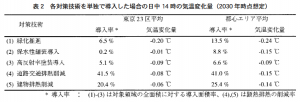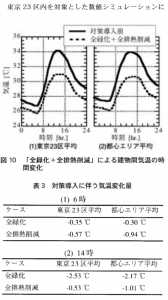Ratul Hora #4
(Res1)5 cases were simulated over Tokyo, 1. 緑化 2.保水材 3.高反射材 4.道路交通排熱削減 5.建物排熱削減 from 2015 to 2030:
After which the max cases of 1 and 4+5 were carried out which shows the following results


The Tokyo area’s 気温has increased over 3°C, looking at the results of 全緑化 of -2.53°C shows that it can basically solve the entire Heat island issue. But that is not what we are here to do. We can’t return an urban area back to a completely “green” area. The city with its concrete etc has other factors that affect our lifestyle. Wind was most probably not simulated because of the large scale and impracticality of the simulation. But these countermeasures are not exactly passive methods (except for green cover) each of them have hidden implementation and management costs. Furthermore, the percentage of area that can be covered using said measures is extremely low, the impact as well is low.
Is it necessary to consider heat island from a city scale perspective? Research(Res2) suggests that UHI effect may contribute to just 2%-4% of gross global warming (Which does not include emissions due to energy consumption). Even if emissions are considered, a lot of the above stated measures do not “directly” deal with reducing energy consumption and release of greenhouse gases per say. The only viable option is to deal with both areas systematically is to first look at the problem of UHI from a “city block” scale. Bringing back design to the equation instead of large scale countermeasures which are trying to tackle something that is developed by small scale development of a landscape.